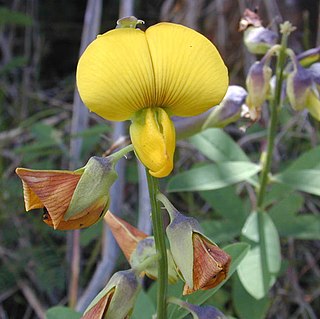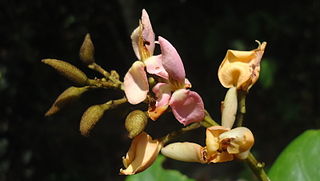
The Faboideae are a subfamily of the flowering plant family Fabaceae or Leguminosae. An acceptable alternative name for the subfamily is Papilionoideae, or Papilionaceae when this group of plants is treated as a family.

Acosmium is a South America genus of flowering plants in the family Fabaceae. Three species are currently recognized. Most Acosmium species have been recently transferred to Leptolobium and one species to the South American Guianodendron while the genus Acosmium itself has been transferred from the tribe Sophoreae to the tribe Dalbergieae in a monophyletic clade informally known as the Pterocarpus clade.

Crotalarieae is a tribe of flowering plants belonging to the family Fabaceae. It includes rooibos (Aspalathus linearis), harvested for sale as a tisane.

Leptolobium is a small Neotropical genus of plants in the family Fabaceae, with ten species currently recognized. With the exception of Leptolobium panamense, which occurs in tropical forests from northwestern South America to Mexico, all species of Leptolobium are restricted to South America and most diverse in Brazil. Most Leptolobium species have been traditionally included in AcosmiumSchott (Fabaceae), but both genera have been recently distinguished based on several vegetative and reproductive traits.
Guianodendron praeclarum is a South American legume endemic to the Guiana Shield. It is the only member of the genus Guianodendron. It has been segregated from Acosmium based on its unique combination of vegetative and floral traits, and it is related to Diplotropis. It is the only member of the genus Guianodendron.

Luetzelburgia is a genus of flowering plants in the legume family, Fabaceae. It belongs to the subfamily Faboideae. It was traditionally assigned to the tribe Sophoreae, mainly on the basis of flower morphology; recent molecular phylogenetic analyses assigned Luetzelburgia into an informal, monophyletic clade called the "vataireoids". Keys for the different species of Luetzelburgia have been published.

The tribe Brongniartieae is one of the subdivisions of the plant family Fabaceae, primarily found in tropical regions of the Americas and in Australia The members of this tribe consistently form a monophyletic clade in molecular phylogenetic analyses. The tribe does not currently have a node-based definition, but morphological synapomorphies have been identified:
"stamens united by filaments in an adaxially open tube; anthers alternately long and basifixed, short and versatile; anther connective inconspicuous; septa present between seeds in pods; aril lateral lobe present and fitting into heel of funicle; fine red glandular processes present in axils; and pollen tricolporate with opercula and no definite endoaperture."

The tribe Dalbergieae is an early-branching clade within the flowering plant subfamily Faboideae. Within that subfamily, it belongs to an unranked clade called the dalbergioids. It was recently revised to include many genera formerly placed in tribes Adesmieae and Aeschynomeneae and to be included in a monophyletic group informally known as the dalbergioids sensu lato. The members of this tribe have a distinctive root nodule morphology, often referred to as an "aeschynomenoid" or "dalbergioid" nodule.

The tribe Indigofereae is a subdivision of the plant family Fabaceae. It is consistently recovered as a monophyletic clade in molecular phylogenies. The Indigofereae arose 30.0 ± 3.3 million years ago.

The tribe Podalyrieae is one of the subdivisions of the plant family Fabaceae.

The tribe Sophoreae is one of the subdivisions of the plant family Fabaceae. Traditionally this tribe has been used as a wastebasket taxon to accommodate genera of Faboideae which exhibit actinomorphic, rather than zygomorphic floral symmetry and/or incompletely differentiated petals and free stamens. Various morphological and molecular analyses indicated that Sophoreae as traditionally circumscribed was polyphyletic. This led to a re-circumscription of Sophoreae, which resulted in the transfer of many genera to other tribes. This also necessitated the inclusion of two former tribes, Euchresteae and Thermopsideae, in the new definition of Sophoreae. Tribe Sophoreae, as currently circumscribed, consistently forms a monophyletic clade in molecular phylogenetic analyses. The Sophoreae arose 40.8 ± 2.4 million years ago.

The tribe Swartzieae is an early-branching monophyletic clade of the flowering plant subfamily Faboideae or Papilionaceae. Traditionally this tribe has been used as a wastebasket taxon to accommodate genera of Faboideae which exhibit actinomorphic, rather than zygomorphic floral symmetry and/or incompletely differentiated petals and free stamens. It was recently revised and most of its genera were redistributed to other tribes. Under its new circumscription, this clade is consistently resolved in molecular phylogenies. Members of this tribe possess "non-papilionate swartzioid flowers[…]largely characterized by a tendency to lack petals combined with a profusion and elaboration of free stamens" and a "lack of unidirectional order in the initiation of the stamens". They also have "complete or near complete fusion of sepals resulting from intercalary growth early in development, relatively numerous stamens, and a single or no petal, with other petals not at all apparent in development." The tribe is predicted to have diverged from the other legume lineages 48.9±2.8 million years ago.

The vataireoids are an early-branching monophyletic clade of the flowering plant subfamily Faboideae that are mostly found in northern South America, primarily Brazil.
Staminodianthus is a genus of trees found in South America. A dichotomous key for the species is available.

The tribe Exostyleae is an early-branching monophyletic clade of the flowering plant subfamily Faboideae that are mostly found in Neotropical rainforests.

The Cladrastis clade is a monophyletic clade of the flowering plant subfamily Faboideae that is found in eastern Asia and southern North America. It is consistently resolved in molecular phylogenies and is sister to the Meso-Papilionoideae. Evidence for the existence of this clade was first proposed based on morphological (floral), cytological, and biochemical evidence. It is predicted to have diverged from the other legume lineages 47.4±2.6 million years ago.
The Andira clade is a predominantly Neotropical, monophyletic clade of the flowering plant subfamily Faboideae. The members of this clade were formerly included in tribe Dalbergieae, but this placement was questioned due to differences in wood anatomy and fruit, seed, seedling, floral, and vegetative characters. Recent molecular phylogenetic evidence has shown that they belong to a unique evolutionary lineage. It is predicted to have diverged from the other legume lineages in the late Eocene).

The Genistoids are one of the major radiations in the plant family Fabaceae. Members of this phylogenetic clade are primarily found in the Southern hemisphere. Some genera are pollinated by birds. The genistoid clade is consistently resolved as monophyletic in molecular phylogenetic analyses. It is estimated to have arisen 56.4 ± 0.2 million years ago. A node-based definition for the genistoids is: "the MRCA of Poecilanthe parviflora and Lupinus argenteus." One morphological synapomorphy has been tentatively identified: production of quinolizidine alkaloids. Some genera also accumulate pyrrolizidine. A new genus, to be segregated from Clathrotropis, has also been proposed to occupy an undetermined position within the genistoid clade.
Meso-Papilionoideae is a monophyletic clade of the flowering plant subfamily Faboideae that includes the majority of papilionoid legumes. This clade is consistently resolved in molecular phylogenies. It contains many agronomically important genera, including Arachis (peanut), Cicer (chickpea), Glycine (soybean), Medicago (alfalfa), Phaseolus, Trifolium (clover), Vicia (vetch), and Vigna.















